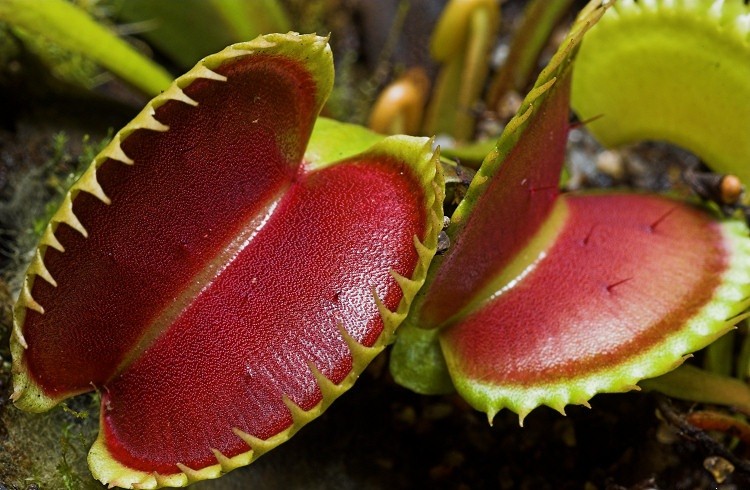Venus flytraps (Dionaea muscipula) are fascinating carnivorous plants native to the coastal plains of the Carolinas. While they are endangered in their natural habitat, commercially grown Venus flytraps are readily available for enthusiasts to cultivate at home. Caring for these unique plants can be a rewarding experience, albeit one that requires understanding their specific needs. This guide will walk you through everything you need to know about Venus flytrap care, ensuring your plant thrives.
 Dionaea muscipula; photo courtesy of Flickr cc/Barry Rice
Dionaea muscipula; photo courtesy of Flickr cc/Barry Rice
Light Requirements for a Healthy Venus Flytrap
Light is paramount for the well-being of your Venus flytrap. These plants demand intense, direct sunlight to flourish. Aim for at least 6 hours of direct sunlight per day, ideally from a south-facing window. For many indoor growers, especially during winter months with shorter days and less intense sunlight, supplemental artificial lighting becomes essential.
A horticultural LED grow light can effectively supplement natural light. Position the light source to illuminate your Venus flytrap for 12 to 16 hours daily. Insufficient light will quickly lead to a decline in your plant’s health, causing weak growth and reduced trap activity.
If you plan to induce winter dormancy for your Venus flytrap, the light requirements will change. We will discuss dormancy in detail later in this guide.
Watering and Humidity for Venus Flytraps
Venus flytraps have specific water requirements that mimic their native wetland environment. The potting medium should always be consistently moist, but never waterlogged. Achieving this delicate balance requires the correct potting mix and a suitable watering method.
Use a pot with drainage holes and place it in a shallow dish filled with about ½ to 1 inch of water. Water your Venus flytrap by adding water to the dish, allowing the plant to absorb moisture from the bottom up. This method keeps the soil consistently moist without oversaturating the top layer. Ensure there’s always a margin of at least 2 inches between the water level in the dish and the soil surface in the pot. Never let the water dish dry out completely.
The type of water you use is crucial. Venus flytraps are highly sensitive to dissolved salts and minerals commonly found in tap water, bottled water, and even filtered water. These minerals can accumulate in the soil and harm or even kill your plant. Therefore, always use distilled water, rainwater, or reverse osmosis (RO) water.
Humidity needs are less critical if you maintain proper watering. The consistently moist soil creates a localized humid environment around the plant. However, if your home environment is particularly dry, especially during winter heating season, the water in the dish might evaporate too quickly. In such cases, consider placing your Venus flytrap in a terrarium with adjustable ventilation. Terrariums help maintain humidity, but ensure adequate ventilation to prevent excessive heat buildup, especially during warmer months, which can cause wilting.
Temperature Considerations for Venus Flytrap Care
Venus flytraps thrive in typical household temperatures, ranging from 65 to 75°F (18 to 24°C). Protect your plant from extreme temperature fluctuations by keeping it away from heating and air conditioning vents, as well as drafty doors or windows.
Colder temperatures will naturally slow down the growth of your Venus flytrap and eventually induce dormancy. If you intend to provide a winter dormancy period, temperature adjustments are necessary, as discussed in the “Winter Dormancy” section.
Re-potting Your Venus Flytrap
Avoid re-potting a newly purchased Venus flytrap immediately. It is generally fine in its original container and potting medium for up to two years. Small plants are typically sold in 2- to 3-inch wide and 3- to 4-inch tall pots.
Venus flytraps are relatively fast-growing plants. After a year or two, you might notice that the plant has filled its container, or new traps are failing to develop properly. These are indicators that it’s time to re-pot. Spring is the ideal season for re-potting, and you can also divide the plant at this time if desired. Even if growth is slow, re-potting every two years is recommended to refresh the growing medium.
When re-potting, choose a pot with drainage holes that is tall enough to maintain a soil surface at least two inches above the water level in the dish (approximately 4 inches tall is usually sufficient).
The potting medium is critical for Venus flytrap health. Use a mixture of half high-quality horticultural sphagnum peat moss and half coarse horticultural sand. Avoid using standard peat or play sand, as they may contain excessive minerals or have clumping issues. You can add a ½-inch layer of horticultural sand on top of the soil mix. This top layer helps to keep the base of the plant drier, reducing the risk of rot and discouraging fungus gnats.
Feeding Your Venus Flytrap: A Carnivorous Diet
Venus flytraps are adapted to nutrient-poor environments and have evolved to trap and digest insects to obtain essential nutrients. Therefore, you should never fertilize the soil of your Venus flytrap, as fertilizers will harm and eventually kill it.
Regular feeding is important for the long-term health and vigorous growth of your Venus flytrap. While they can survive for extended periods without food, they will grow much more slowly. If your plant is outdoors during the summer, it may catch enough insects on its own.
In their natural habitat, Venus flytraps primarily consume ants and spiders, along with grasshoppers, beetles, and other crawling insects. Never feed your Venus flytrap meat or human food. Suitable live prey includes flies, spiders, crickets, and slugs. Live mealworms or crickets purchased from pet stores are convenient options. Avoid feeding ants as a primary diet, as they may not provide sufficient nutrition and could have come into contact with household toxins. Caterpillars are also not recommended, as some can escape the traps.
Feed each trap appropriately sized prey – no larger than about 1/3 the size of the trap. Overly large insects can take too long to digest, potentially leading to bacterial rot and trap death. Venus flytraps are sensitive to movement. When live prey is placed inside a trap, the movement stimulates the trap to close and begin the digestion process, sealing tightly for days or even weeks.
You don’t need to feed every trap on your plant at each feeding session; feeding just one or two traps is sufficient. It’s also fine to feed the same traps repeatedly. Traps will naturally die off after several digestion cycles and be replaced by new growth.
Using Dried Bloodworms: Dried bloodworms, commonly available as fish food in pet stores, are a convenient and reliable alternative to live insects. Ensure the product contains only bloodworms without any additives. To feed, rehydrate a small amount of dried bloodworms with a few drops of water until they become soft and meaty. Use tweezers to place a small piece (about ⅓ the size of the trap) inside a trap. Gently massage the outside of the trap to simulate live prey movement and encourage the trap to close and seal, initiating digestion.
Winter Dormancy for Venus Flytraps
Whether winter dormancy is strictly necessary for Venus flytraps is debated among experts. However, in their native Carolinas, these plants naturally experience a dormancy period during winter, which serves as a natural rest and rejuvenation cycle. If providing sufficient light during winter is challenging, or if your plant appears to need a rest, inducing dormancy can be beneficial.
Dormancy is triggered naturally by decreasing daylight hours and cooler temperatures in the fall. Around November, you may notice your Venus flytrap’s leaves starting to die back unless you supplement with grow lights and maintain warmer temperatures.
To induce dormancy, allow natural daylight to decrease and gradually reduce temperatures to around 45 to 50°F (7 to 10°C). Stop feeding and reduce watering to just barely moisten the growing medium, allowing the plant to rest. Once the leaves have completely turned black, you can trim them off. Around March, as daylight and temperatures increase, you can gradually return your Venus flytrap to its usual growing conditions and routine.
Venus Flytrap Flowers
Mature Venus flytraps produce white flowers on tall stalks in early spring. It is generally recommended to remove flower stalks before they bloom. Flowering consumes significant energy from the plant, potentially reducing leaf and trap production. When you observe a long, stalk-like growth emerging (an inch or more), cut it back to the base of the plant.
Common Issues and Things to Watch For
Color: Healthy Venus flytraps are typically green when grown indoors. Intense light can encourage reddish coloration. Some cultivars, like Dionaea ‘Red Dragon’, D. ‘Red Piranha’, and D. ‘Colin’s Red Sunset’, are bred for more prominent red coloration. In the wild, this red color, along with a subtle sweet scent, helps attract prey.
Black Leaves: It is normal for Venus flytrap leaves to turn black and die after a few months. This is part of their natural growth cycle. New leaves will continuously emerge to replace older ones. You can trim off completely black leaves.
Sickly Plant: A common sign of an unhealthy Venus flytrap is lack of sufficient sunlight. Ensure your plant receives bright, direct sun or adequate supplemental lighting. A dimly lit windowsill is insufficient. Other problems can include salt buildup in the soil due to using tap water, root rot from overly wet conditions, or allowing the roots to dry out completely, even briefly.
Seasonal Leaf Variation: Venus flytrap leaves may appear different in spring and fall compared to summer. During summer, they may produce more elongated, upright leaves on longer petioles.
By following these comprehensive care guidelines, you can successfully cultivate healthy and thriving Venus flytraps and enjoy these remarkable carnivorous plants in your home.
*Conservation Note: Wild Venus flytrap populations are facing threats, and the U.S. Fish and Wildlife Service is considering Endangered Species Act protection. Habitat loss, pollution, fire suppression, and poaching are major concerns. Support conservation efforts by purchasing commercially grown plants from reputable growers, ensuring you are not contributing to the decline of wild populations. Avoid plants that appear to be wild-collected and opt for plants grown in uniform potting mixes by responsible nurseries. Purchasing commercially grown plants helps ensure the continued survival of wild Venus flytrap populations by reducing demand for illegally collected specimens.

